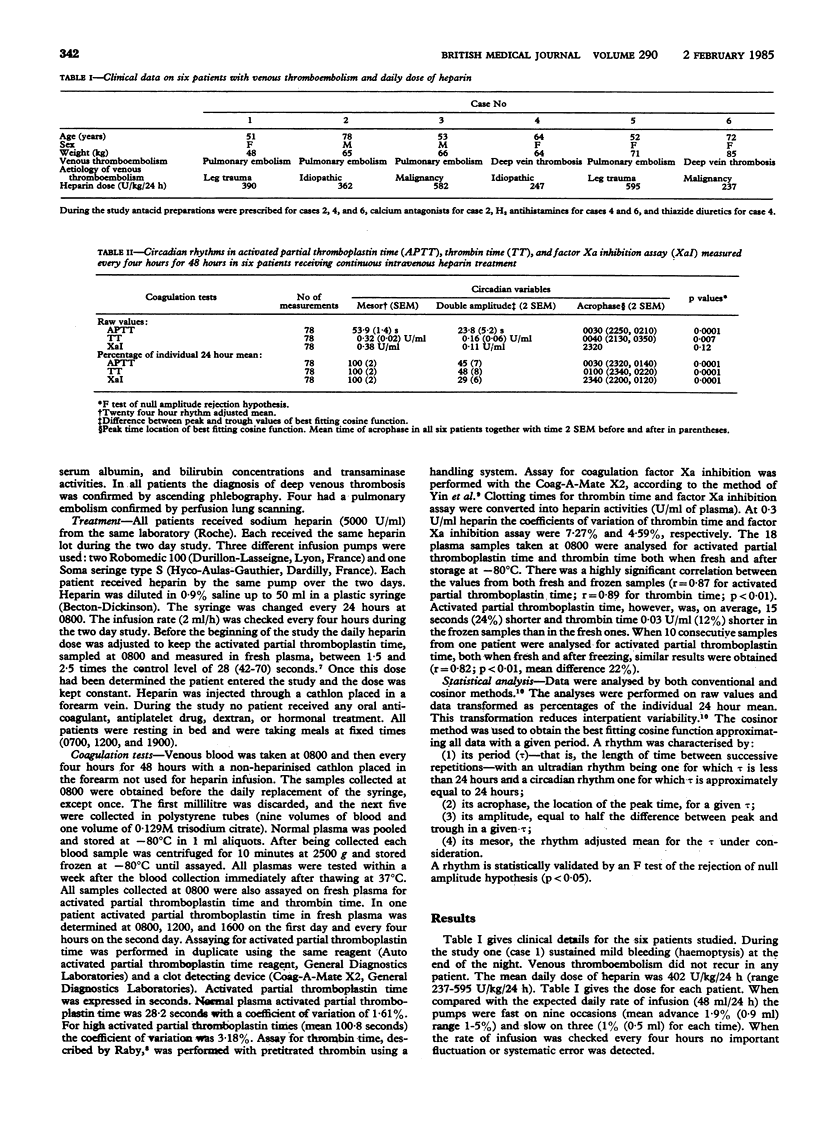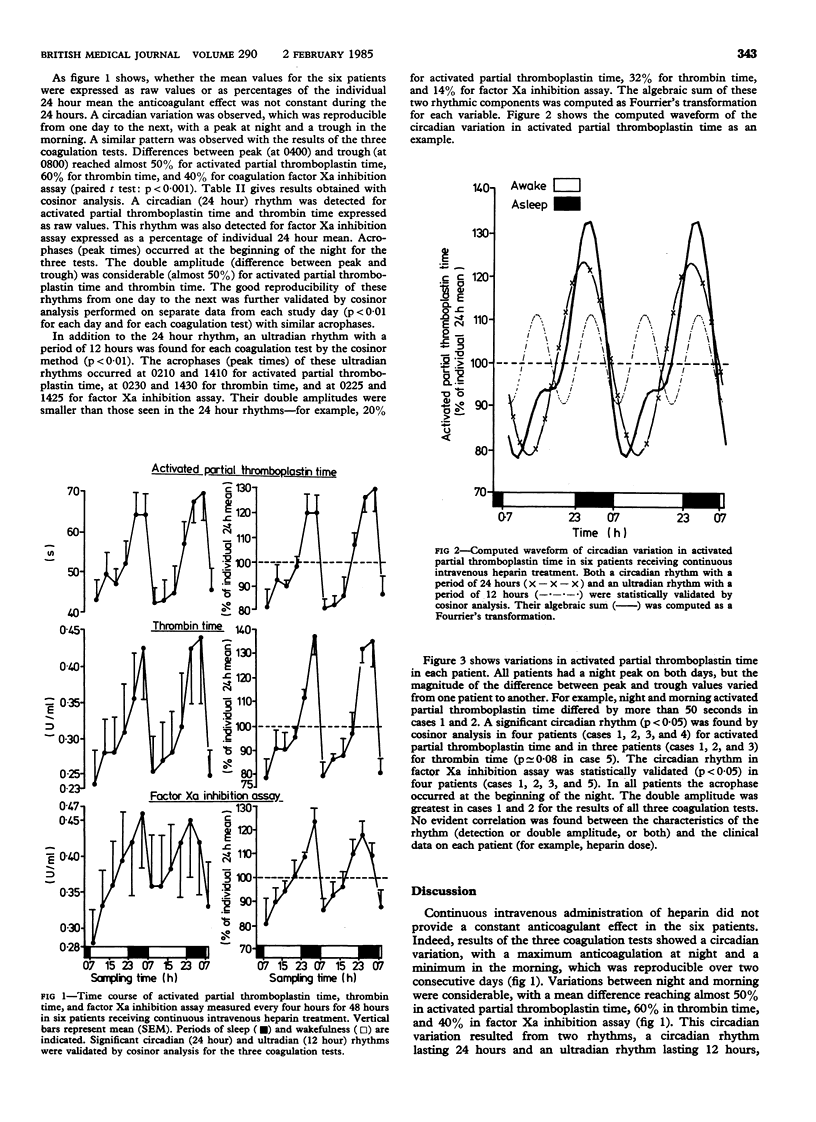Abstract
Six patients with venous thromboembolism were treated with heparin, administered intravenously by a constant infusion pump. The initial daily dose of heparin was adjusted to keep the activated partial thromboplastin time, sampled at 0800, between 1.5 and 2.5 times the control level. Once that level was obtained, this dose was kept constant. Anticoagulation was thereafter measured, every four hours for 48 hours, by activated partial thromboplastin time, thrombin time, and coagulation factor Xa inhibition assay. The results of all three coagulation tests showed a circadian variation in the six patients. Maximum values were achieved at night and minimum values in the morning. These circadian variations were reproduced for two consecutive days. Differences between night and morning values reached almost 50% for activated partial thromboplastin time, 60% for thrombin time, and 40% for factor Xa inhibition assay. This circadian variation resulted from two rhythms, a circadian rhythm lasting 24 hours and an ultradian rhythm lasting 12 hours, which were detected by cosinor analysis for each coagulation test (p less than 0.01). A circadian rhythm was detected individually in most of the patients for each coagulation test (p less than 0.05). All patients had a nocturnal peak in activated partial thromboplastin time on both days. In four patients this peak exceeded the upper desired limit of activated partial thromboplastin time. These rhythms should be taken into account when evaluating the dosage of heparin to be administered.
Full text
PDF



Selected References
These references are in PubMed. This may not be the complete list of references from this article.
- BARRITT D. W., JORDAN S. C. Anticoagulant drugs in the treatment of pulmonary embolism. A controlled trial. Lancet. 1960 Jun 18;1(7138):1309–1312. doi: 10.1016/s0140-6736(60)92299-6. [DOI] [PubMed] [Google Scholar]
- Basu D., Gallus A., Hirsh J., Cade J. A prospective study of the value of monitoring heparin treatment with the activated partial thromboplastin time. N Engl J Med. 1972 Aug 17;287(7):324–327. doi: 10.1056/NEJM197208172870703. [DOI] [PubMed] [Google Scholar]
- Brandt J. T., Triplett D. A. Laboratory monitoring of heparin. Effect of reagents and instruments on the activated partial thromboplastin time. Am J Clin Pathol. 1981 Oct;76(4 Suppl):530–537. [PubMed] [Google Scholar]
- Hattersley P. G., Mitsuoka J. C., King J. H. Heparin therapy for thromboembolic disorders. A prospective evaluation of 134 cases monitored by the activated coagulation time. JAMA. 1983 Sep 16;250(11):1413–1416. doi: 10.1001/jama.250.11.1413. [DOI] [PubMed] [Google Scholar]
- Kakkar V. V., Djazaeri B., Fok J., Fletcher M., Scully M. F., Westwick J. Low-molecular-weight heparin and prevention of postoperative deep vein thrombosis. Br Med J (Clin Res Ed) 1982 Feb 6;284(6313):375–379. doi: 10.1136/bmj.284.6313.375. [DOI] [PMC free article] [PubMed] [Google Scholar]
- Mant M. J., O'Brien B. D., Thong K. L., Hammond G. W., Birtwhistle R. V., Grace M. G. Haemorrhagic complications of heparin therapy. Lancet. 1977 May 28;1(8022):1133–1135. doi: 10.1016/s0140-6736(77)92388-1. [DOI] [PubMed] [Google Scholar]
- Nelson W., Tong Y. L., Lee J. K., Halberg F. Methods for cosinor-rhythmometry. Chronobiologia. 1979 Oct-Dec;6(4):305–323. [PubMed] [Google Scholar]
- Petralito A., Mangiafico R. A., Gibiino S., Cuffari M. A., Miano M. F., Fiore C. E. Daily modifications of plasma fibrinogen platelets aggregation, Howell's time, PTT, TT, and antithrombin II in normal subjects and in patients with vascular disease. Chronobiologia. 1982 Apr-Jun;9(2):195–201. [PubMed] [Google Scholar]
- Raby C. Héparinothérapie contrôlée. Presse Med. 1967 Jun 17;75(29):1526–1526. [PubMed] [Google Scholar]
- Reinberg A., Smolensky M. H. Circadian changes of drug disposition in man. Clin Pharmacokinet. 1982 Sep-Oct;7(5):401–420. doi: 10.2165/00003088-198207050-00002. [DOI] [PubMed] [Google Scholar]
- Reinberg A., Smolensky M., Lévi F. Clinical chronopharmacology. Biomedicine. 1981 Dec;34(4):171–178. [PubMed] [Google Scholar]
- Wessler S., Gitel S. N. Heparin: new concepts relevant to clinical use. Blood. 1979 Apr;53(4):525–544. [PubMed] [Google Scholar]
- Wilson J. E., 3rd, Bynum L. J., Parkey R. W. Heparin therapy in venous thromboembolism. Am J Med. 1981 Apr;70(4):808–816. doi: 10.1016/0002-9343(81)90537-4. [DOI] [PubMed] [Google Scholar]
- Yin E. T., Wessler S., Butler J. V. Plasma heparin: a unique, practical, submicrogram-sensitive assay. J Lab Clin Med. 1973 Feb;81(2):298–310. [PubMed] [Google Scholar]


